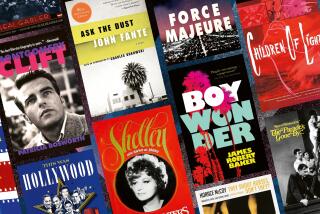David Goodis bio finally published in English -- after 30 years

If, like me, you discovered David Goodis through the 1980s Black Lizard reprints of his novels, Philippe Garnier’s “Goodis: A Life in Black and White” (Black Pool Productions: 216 pp., $25 paper) has long been something of a mythic touchstone. Published in France in 1984, it remained unavailable in English for decades — until now, when Garnier’s own translation has been released.
Goodis is, I think, the greatest of the pulp writers who churned out paperback originals in the 1950s: dime store crime fiction that often rose to the level of art. Jim Thompson, Charles Willeford, Harry Whittington — these were his contemporaries, his peer group, although the truth is Goodis had no peers.
Born in Philadelphia in 1917, he published his first novel, “Retreat from Oblivion,” in 1938, and had his one real hit eight years later with the thriller “Dark Passage,” which was serialized in the Saturday Evening Post and turned into a vehicle for Bogart and Bacall. This led to a three-year stint in Hollywood.
“[N]othing I did in the Hollywood studios is worth mentioning,” he averred shortly before his death in January 1967 at age 49. By 1950, he was back in Philadelphia, and his books from that point trace what looks like a very individual retrenchment, built around characters who once had, or represented, something of value (a career, a sense of self-worth) but have lost it, irrevocably.
Garnier’s book is the only full biography of Goodis — although biography isn’t exactly what this is. Yes, it offers details about the author and his shadowy legacy, but it’s also too personal, too much about Garnier’s search for information, to function as the story of a life.
Rather, it’s a saga of obsession: Garnier’s with learning what he can about Goodis, and Goodis’ with retreating from the world. In that sense, the book is less a portrait than a set of sketches of a writer who preferred to remain willfully obscured.
This is the story told by his friends, whom Garnier interviewed — they recall a prankster who deflected confidences with a steady stream of jokes — and it also marks his family and career. Until his death, Goodis lived in the house where he’d been raised, for much of that time with his parents.
There were occasional spikes of visibility; in 1960, François Truffaut based his film “Shoot the Piano Player” on Goodis’ novel “Down There.” And yet, in his isolation, his alienation, we see the true source of his writing, which takes place in a world of diminished expectations, in which the worst thing one can do is hope.
Garnier makes much of the fact that Goodis wasn’t a down-and-outer, that his portrayals of street life were unrealistic, secondhand. This is true enough, I suppose, despite his predilection for rough sex and inner-city dives, but in the end it seems beside the point.
What’s enduring about Goodis’ fiction, after all, is its emotional territory, its point-by-point evocation of despair. “It would of course be tempting,” Garnier writes, “to reduce the Enigma of David Goodis to the cheap Freudianism one finds in his later novels, but nothing is that simple. Still, we shouldn’t ignore the clues he offers in his books either, goading us on like a treasure hunt.”
Garnier seems to mean this as a putdown, an indication that Goodis was as withholding in his fiction as he was in his life. But that’s not really true, is it? — because Goodis’ novels, for all their purported disposability, get at something, what Geoffrey O’Brien has called a “sense of impending internal catastrophe.”
When Garnier began his research in the early 1980s, Goodis’ books were out of print in the United States. His rehabilitation, such as it is, began with those Black Lizard reprints; now five of his novels have been collected by the Library of America.
Still, as Garnier rightly notes, we shouldn’t make too much of this, for he is too idiosyncratic, too bleak, to cross over like Willeford or Thompson.
“There were too many questions,” Goodis writes in the 1952 novel “Of Tender Sin.” “But all at once they merged and became a single question that had nothing to do with anyone but himself.”
ALSO:
Karen Russell’s ‘Sleep Donation’ is a digital dream
For April Fools’ and baseball season: George Plimpton
Denis Johnson is back, with first published story in years
More to Read
Sign up for our Book Club newsletter
Get the latest news, events and more from the Los Angeles Times Book Club, and help us get L.A. reading and talking.
You may occasionally receive promotional content from the Los Angeles Times.








